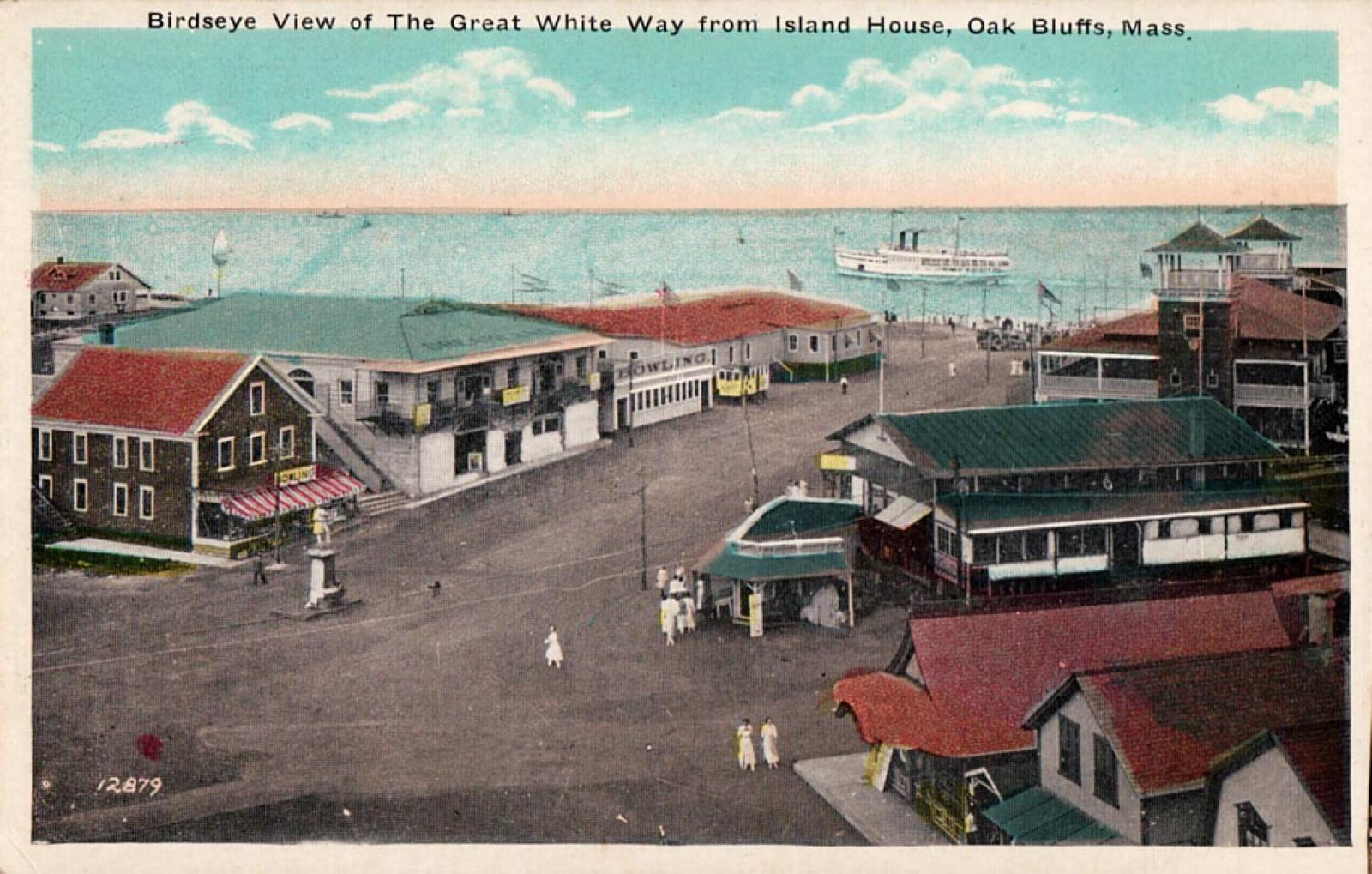The Great White Way, on Oak Bluffs avenue between Sea View and Lake avenues, was the heart of the summer resort’s entertainment area. Its evolution can be traced in a group of postcards from the first quarter of the 20th century.
One of the avenues’ earliest attractions was the Vineyard skating rink, a mammoth structure with multiple towers, constructed in 1878 at the corner of Sea View and Oak Bluffs avenues. Built for Samuel Winslow, inventor of the Vineyard Roller Skate, the rink also featured polo, costume carnivals and bicycle exhibitions. A Chamberlain postcard graphically depicts the remains of the structure after a disastrous fire in 1892.
An early bird’s-eye view postcard of Oak Bluffs avenue shows frame structures, including at least two bowling alleys and several stables, with Lake Anthony, later Oak Bluffs Harbor, in the background. The Civil War Monument is visible in its original location at the beginning of Circuit avenue.
A later postcard titled Bird’s Eye View of the Great White Way from Island House indicates significant changes on the avenue. Dreamland, a large, cement-block building, was set between two of the bowling alleys with a winning combination of moving picture theatre and dance hall.
The Nonpareil Diner, M. V. Ripley’s popular eatery in a railroad car, is also seen in the postcard. Open virtually 24 hours a day, it was strategically located near the ferry landing and all the entertainment facilities.
Dreamland was not the only moving picture venue on the avenue. The Strand, at the corner of Oak Bluffs avenue and Circuit avenue extension, replaced one of the bowling alleys and Odd Fellows Hall. Only a small, one-story retail shop separated the two massive theatres.
The Tivoli building, at the corner of Sea View and Oak Bluffs avenues, also offered a variety of entertainment options. A Chamberlain 1908 postcard features the Tivoli two years after it was constructed. There were retail shops, including an ice cream parlor, the Tivoli Temple (a theatre) and a dance hall. Advertisements promoted Will Hardy’s famous orchestra from Worcester and lauded the high class environment.
Take Your Choice is the apt caption of a sepia-toned Chamberlain postcard. Within a cluster of buildings on a triangular piece of land bordered by Oak Bluffs, Lake and Kennebec avenues were the Oak Bluffs Merry-Go-Round, later called the Flying Horses, and two souvenir shops, the Pagoda Gift Shop and Macy’s.
Charles Tallman, the sole survivor of the wreck Christina in 1866, sold souvenirs, peanuts, and photos of himself in the octagonal building, called the Pagoda, when it was located closer to Sea View avenue. It was later moved next to the carousel where it remained a souvenir shop. Nearby was Macy’s with a rack of postcards prominently displayed in front of the shop.
The Flying Horses was the real crowd pleaser. Originally on Coney Island, it was transported to the Island in the 1880s and sited behind the skating rink on the bluff. Later, the carousel along with its open porch was moved to the plot of land where it stands today. The porch was enclosed, initially housing a harness shop, and later a restaurant.
A memorable Chamberlain postcard postmarked 1909 shows the Flying Horses with a crowd of spectators gathered to view a newly arrived band about to march up Circuit avenue.
Three of Oak Bluffs avenue’s most historic landmarks have disappeared — the old skating rink, the Nonpareil Diner and the Tivoli Building. However, the two theatre buildings, one still a theatre and the other housing a variety of enterprises over the years, and the hodgepodge of structures across the street remain as reminders of The Great White Way. The Flying Horses continues to draw summer visitors and is one of the Island’s star attractions.







Comments
Comment policy »